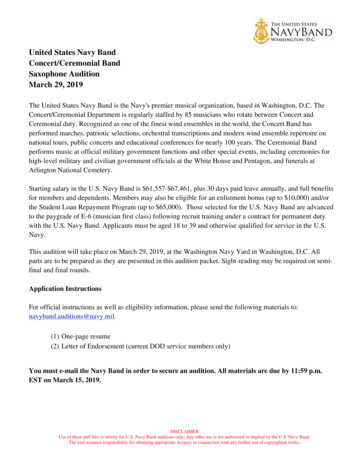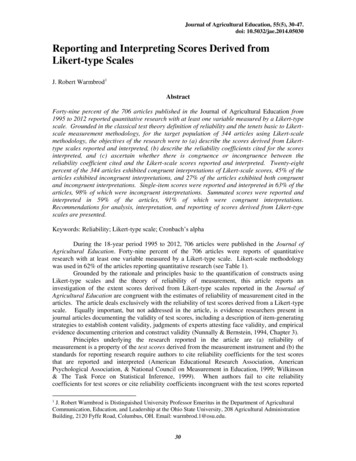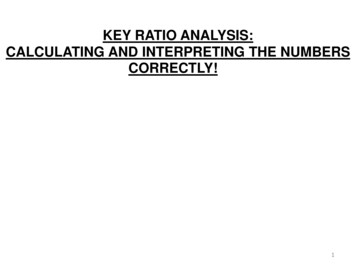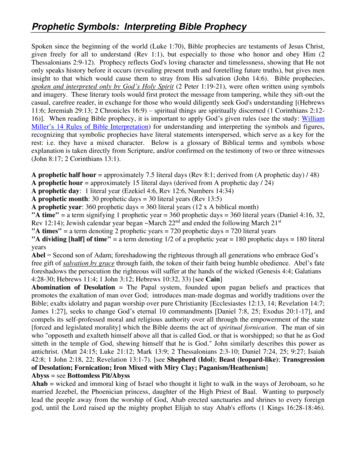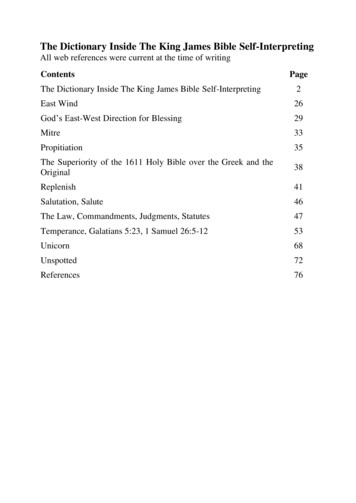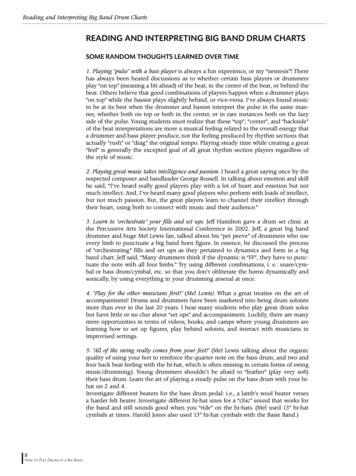
Transcription
Reading and Interpreting Big Band Drum ChartsREADING AND INTERPRETING BIG BAND DRUM CHARTSSOME RANDOM THOUGHTS LEARNED OVER TIME1. Playing “pulse” with a bass player is always a fun experience, or my “nemesis”! Therehas always been heated discussions as to whether certain bass players or drummersplay “on top” (meaning a bit ahead) of the beat, in the center of the beat, or behind thebeat. Others believe that good combinations of players happen when a drummer plays“on top” while the bassist plays slightly behind, or vice-versa. I’ve always found musicto be at its best when the drummer and bassist interpret the pulse in the same manner, whether both on top or both in the center, or in rare instances both on the lazyside of the pulse. Young students must realize that these “top”, “center”, and “backside”of the beat interpretations are more a musical feeling related to the overall energy thata drummer and bass player produce, not the feeling produced by rhythm sections thatactually “rush” or “drag” the original tempo. Playing steady time while creating a great“feel” is generally the excepted goal of all great rhythm section players regardless ofthe style of music.2. Playing great music takes intelligence and passion. I heard a great saying once by therespected composer and bandleader George Russell. In talking about emotion and skillhe said, “I’ve heard really good players play with a lot of heart and emotion but notmuch intellect. And, I’ve heard many good players who perform with loads of intellect,but not much passion. But, the great players learn to channel their intellect throughtheir heart, using both to connect with music and their audience.”3. Learn to “orchestrate” your fills and set ups. Jeff Hamilton gave a drum set clinic atthe Percussive Arts Society International Conference in 2002. Jeff, a great big banddrummer and huge Mel Lewis fan, talked about his “pet peeve” of drummers who useevery limb to punctuate a big band horn figure. In essence, he discussed the processof “orchestrating” fills and set ups as they pertained to dynamics and form in a bigband chart. Jeff said, “Many drummers think if the dynamic is “FF”, they have to punctuate the note with all four limbs.” Try using different combinations, i. e.: snare/cymbal or bass drum/cymbal, etc. so that you don’t obliterate the horns dynamically andsonically, by using everything in your drumming arsenal at once.4. “Play for the other musicians first!” (Mel Lewis). What a great treatise on the art ofaccompaniment! Drums and drummers have been marketed into being drum soloistsmore than ever in the last 20 years. I hear many students who play great drum solosbut have little or no clue about “set ups” and accompaniment. Luckily, there are manymore opportunities in terms of videos, books, and camps where young drummers arelearning how to set up figures, play behind soloists, and interact with musicians inimprovised settings.5. “All of the swing really comes from your feet!” (Mel Lewis talking about the organicquality of using your feet to reinforce the quarter note on the bass drum, and two andfour back beat feeling with the hi-hat, which is often missing in certain forms of swingmusic/drumming). Young drummers shouldn’t be afraid to “feather” (play very soft)their bass drum. Learn the art of playing a steady pulse on the bass drum with your hihat on 2 and 4.Investigate different beaters for the bass drum pedal: i.e., a lamb’s wool beater versesa harder felt beater. Investigate different hi-hat sizes for a “chic” sound that works forthe band and still sounds good when you “ride” on the hi-hats. (Mel used 13” hi-hatcymbals at times. Harold Jones also used 13” hi-hat cymbals with the Basie Band.)8How to Play Drums in a Big Band
Do’s and Don’ts of Big Band DrummingDO’S AND DON’TS OF BIG BAND DRUMMINGThis is a short, simple list of what to do and what to possibly avoid when approachingbig band reading, performing, and development. Many drummers are taught to readwith their eyes first and use their ears only in cases of extreme emergency. I found,later than sooner, that the drummers I most enjoyed listening to in the big band setting were ones that were not necessarily the strongest readers.These extremely talented individuals possess a “sixth sense” inherent in all avid improvisers. Their innate ability to sound as if they were not only reading the chart but thatthey wrote it was mind-boggling. This visceral sense of when to do something “flashy”or technical, or when not to do it, is a learned skill requiring acute editing. As you gainmore and more knowledge of big band drumming and meet more drummers, you willlearn that musicianship always “trumps” the technician who plays licks which drawattention to himself/herself.I once had the opportunity to ask Mel Lewis how he approached a new big band chart.I asked him if he tried to catch all the horn figures on the first reading, etc., etc Hesaid, “I never catch all the figures the first, second, or even third time through a newchart. The first time through, I play the time and the feel of the chart as I watch thehorn figures go by. I gradually decide which figures are the most important and whichones need a bass drum or a snare/rim shot, etc. I’m fortunate in having my own bigband. I’ve always taken the stance that less is more.”10How to Play Drums in a Big Band
Rhythm Section Set UpsRHYTHM SECTION SET UPSIn a traditional rhythm section set up like the one pictured in example 1, the drum set’shi-hat is placed beside the 2nd trombonist. The second trombonist is the first in therow of trombonists. The drummer’s music stand is the only thing separating the drummer’s hi-hat from the line of trombones. With the music stand placed on the outsideedge of the hi-hat, the drummer will have a direct line of site to the director while reading any big band chart. As a young drummer learns the technique of looking ahead,as opposed to reading one beat/measure at a time, he/she will begin to spend moretime with his/her “head out of the music.” Having your head out of the music leads toa more visceral performance. And, it’s more fun for everyone when the drummer paysattention to the nuances of the arrangement, such as time feel, dynamics, phrasing andsuch. This ability to give the chart your full attention also comes from knowing thechart: i.e. melody location, “shout” section location, soli sections, and so forth.Example 1 (Traditional Rhythm Section umSetGtr.AmpSaxophonesGuitaristThis second set up comes from the time I spent on the road with the Count BasieOrchestra. This is the exact set up that they had in the band’s “rider” and, the rhythmsection emulated this whenever possible. There are always exceptions to the rulewhich are dictated by the performance space, the size of the stage, or the acoustics ofa given performance space. In the Basie Orchestra, the lid of the piano taken off whenthe band was able to use this “set up”. Basie’s piano intros and endings are classic andhad to be heard by everyone in the band as well as the listeners in the audience. Noticethat like set up #1, the drummer is still set up in line with the trombones. There is a“clear sight line” for the entire rhythm section to see the band and the director/leader.These two set ups are favorites from a drummer perspective. Experiment with some ofyour own if possible.Example 2 (Basie Rhythm Section honesGtr.AmpGrand PianoGuitarist17How to Play Drums in a Big Band
Basie’s BluesBASIE’S BLUESTrying to perfectly capturing the spirit of the Count Basie Orchestra is something Ihave first hand knowledge of and in this instance, Russell Schmidt has done it! Thisarrangement is complete with quarter note Freddie Green style rhythm guitar “comping”. Basie was a master of understated intros, comping, and soloing. His band workedin concert to produce a quiet, dry pulsating quarter note groove contrasted by explosive volume shifts that often made the listeners literally jump out of their seats.“Basie’s Blues” is a traditional 12 bar blues tune in the key of Eb. The chart opens witha full big band “shout” that lasts for only 10 bars. I used something called a “riverboatshuffle” (example 1). I first heard this groove listening to Clark Terry’s large and smallgroups in the 1970’s. When Clark conducted clinics with college rhythm sections, hewould sing this riverboat shuffle rhythm to the drummer and bassist, gesturing untilthe students obtained his desired effect.Example 1Cue 1 "Sonny Payne" style q 108Riverboat Shuffle a la Clark Terry3 c Œj¿ œ¿ œ¿ ¿ ¿ œ¿ ¿ ¿ œ¿ ¿ ¿ œ¿ ¿ ¿ œ¿ ¿ ¿ œ¿ ¿ ¿ œ¿ ¿ ¿ œ 3œœœ¿œœ ¿œ œ ¿œœ ¿œ œ ¿œœ ¿œ œ ¿œœœ¿œœœ35¿¿ ¿ œj œ œj œ œ œ œ¿ ¿ ¿9 ä.æπ3œ¿ œ œ¿ œ ¿œ œ œ œ œ ¿œ¿ ¿ ¿¿¿ ¿‰ œ œj œ œ œ œ¿ ¿ ¿ ¿œ œ¿ œ¿ œ H.H./L.H.¿œœœœœ¿ œ¿ P14After the 10 bar intro, the dynamic level drops from fortissimo to mezzo piano for thecarefully edited piano solo by Bill Dobbins. (As in the Basie tradition, over emphasisthe dynamics a bit.) The piano solo lasts for 2 choruses and as always during a “Basie”style piano solo, I try to play very tastefully and sparse in nature. Watch my transcription to compare the contrasting style used “setting up” the ensemble figures in thebeginning with the thinner texture of using just the hi-hat to “comp” for the piano soloat letter A.The drummer’s main function on the piano solo at letter A, besides bringing contrastto the opening, is to “lock in” with the bass and rhythm guitar to produce that quiet,but powerful quarter note groove which distinguished the Basie Band from all others.This style of playing to the quarter note has come to be known as “the Basie QuarterNote” style. Notice the subtle changes in the standard jazz cymbal pattern on theclosed hi-hat. The bass drum is also used for occasional punctuation on the ands andupbeat of beat 3. This is effective in breaking up the quarter note and avoids monotony and/or a groove that sounds stagnant.18How to Play Drums in a Big Band
BurungkakaBurungkaka Chart Diagram:intro-bass ostinatomuted br.17. melody (tbne)25.2nd X muted ��8––––––I33. Bridge/breaks cont.1st ending (4 meas.)2nd ��––I––2––I break 2 meas. :II time 2 meas. :II break 2 I53. bone solo 61. (2 choruses) 69.WW pads 2nd X thru bone solo77.1st/2ndlast –––:II––2––I break 2 meas.89. Trombone soli97.105.113. �–––––I121. pno solo (bkgrds 2nd X)137.145. 1st –4–––:II153. 2nd ending/ostinato extendedRepeat this 12 bars 4 ody return tbneuse the 8 bars to return to brushes165.173. melody orchestrated181. ––I189. bridge cont. ostinato returnsimili repeat 8x’s201. endingritard and �–––––II32How to Play Drums in a Big Band
BurungkakaBurungkakaTraditionalArr.: Bill DobbinsSwing q 240Tacet 1st timeBrushes c . ’ ’ ’ ’ ’ ’ ’ ’ ’ ’ ’ ’ ’ ’ ’ ’ ’ ’ ’ ’ ’ ’ ’ ’P97 ’ ’ ’ ’ ’ ’ ’ ’ . ’ ’ ’ ’ ’ ’ ’ ’ ’ ’ ’ ’ ’ ’ ’ ’1713(Ens: 2nd X only)jœ Œ ‰ œ Œ œ œ Œ. ’’’’ ’’’’ ’’’’ ’’’’ .’’’ ’ ’’’ ’19œ.jœ œ œ œ œ Œ jœœ.Ó ’’ ’’ ’’’’ ’’’ ’ ’’’’25jœ Œ ‰ œ Œ œ œ Œœ.jœ Œ œ‰ œ.w’’’’ ’’’ ’ jœ œ.œ Œ œ.jœ ’’’ ’ ’’’ ’ ’’ ’’ ’’’’ ’’’ ’ ’’’’3331w ’ ’ ’ ’ ’ ’ ’ ’ Œ ‰ Û- J38 Œ ‰ Û- J44 ‰ œ. ’’’ ’Œ ‰ Û- J’’’’ ’’’’ Œ ‰ Û J41(Ens: 2nd X only)’’’’ ’’’’ Œ ‰ Û JŒ ‰ Û- J1. ’œ ’ ’’œ ’œ ’ ’’œÛ Œ Ó jjœ œ œ’ ’ ’ ’Ó ‰ œ.’ ’ ’ ’ ’ ’ ’ ’ .F(Bass) 2010 advance music, all rights reserved33How to Play Drums in a Big Band
La Curandera NegritaLa Curandera Negrita Chart Diagram:Intro5. Melody A sec. tbones21. A sec. ww more –––––––I37. B sec. add trptsBreaktimeBreak/lead �–––––I––––2––––I53. Melody 8ba trbns69. interludediminished bass mvt.81. send 8––––––II89. modulation/send off totenor solo 9th bar105. turnaround117. solo cont.Backgrounds 2nd ––––I133. turnaround1st. end2nd end w/shout figures hemiola, –––II161. tacet/malletsplay mallets/interlude leading to the tromb.mallets embellish figures written on –10–––––––––I179. interlude cont.trombone solo startssticks189. bone solo form3 min. 51 �8–––––––I197. solo cont.“turnaround”209. solo A sec.225. turnaround 233. Transition backdominant 7thto original �–12–––––––I245. “Recap”253. melody w/original key, melody, etc.embellishment269. ––––––––INegrita cont.281. drum solo trading 27 meas. total!Band/hemioladrums/conga BandDrum set BandConga BandDrum ––––I308. drum/band trading cont.band hemiola drum setBreak!321. bass line in orig.Dr. fill329. recapw/dim. 22very soft �––––––I345. soft cym. rollHolds and –––––4–––––––II59How to Play Drums in a Big Band
La Curandera NegritaLa Curandera NegritaComp.: Joey SellersRideSN 68BD‹ ‹œ HHœ FTMT œœ 7‹ ‹ ‹ ‹ ‹ ‹ ‹ œ ‹œ.œ.(SN cross stick)Fill (Tacet if Conga)3„ œ œ œŒ.f ‹‹ ‹ ‹ ‹‹ ‹ ‹œœ.œ.‹‹ ‹ ‹ ‹‹ ‹ ‹œ.œ ‰œ œœToca Siempre (play always)2«‹‹ ‹ ‹ ‹‹ ‹ ‹œ.œ ‰œ œœ2«2«sxsÛ Û Û Û415 2«ÛÛÛÛ ‹‹ ‹ œ‹ ‹‹ ‹ ‹ Û Œ Œ.œ. œ.J2«423 2«2« ‹‹ ‹ ‹ ‹‹ ‹ ‹ ‹‹ ‹ ‹ ‹‹ ‹ ‹œœ. œ.œ . œ .œ œF212«Û Û Û Û2«431 2«2«2«37 ‹‹ ‹ œ‹‹ ‹ ‹ ‹œ œ œ.J ‹‹ ‹ œ‹ ‹ ‹ œ‹
Investigate different beaters for the bass drum pedal: i.e., a lamb’s wool beater verses a harder felt beater. Investigate different hi-hat sizes for a “chic” sound that works for the band and still sounds good when you “ride” on the hi-hats. (Mel used 13” hi-hat cymbals at times. Harold Jones also used 13” hi-hat cymbals with the Basie Band.) Reading and Interpreting Big Band .
